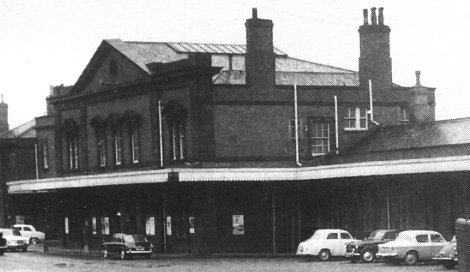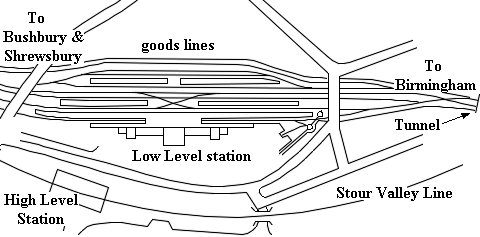 |
Rails In Wolverhampton - The Early Years
by Bev Parker |
 |
|
Wolverhampton Low Level Station
It was originally planned as a part of the Oxford, Worcester & Wolverhampton
Railway, but the Act passed on 14th August 1848 stated that it was to be
constructed and maintained jointly for the use of the Shrewsbury &
Birmingham
Railway, the Oxford, Worcester & Wolverhampton Railway, and the Birmingham,
Wolverhampton & Dudley Railway. The buildings were designed by John Fowler,
the track layout by Henry Robertson, and the overall roof by I. K. Brunel.
The
Oxford, Worcester & Wolverhampton line opened on 1st July 1854, and the
Birmingham, Wolverhampton & Dudley opened on 14th November 1854, but
work on the station was not completed until late 1855. It was initially
called
Wolverhampton Joint station but was renamed Wolverhampton Low Level in
April 1856. |
|

The station entrance in the 1960's. |
The station was built
of blue bricks with stone decorations, and a large span overall
iron roof. There was a grand entrance hall with booking offices, railway
company
offices, waiting and refreshment rooms.
The very wide and long platforms
prevented overcrowding and allowed both up and down trains to arrive on the
same platform at the same time. |
The platforms were linked by an iron bridge.
All of this
was very different to the basic facilities that were on offer at the High
Level station,
and many alterations and improvements took place in the intervening years.
Some
of the more notable changes were:
| 1st April 1869 |
Conversion of the broad gauge track
to standard gauge. |
| April 1899 |
The new carriage shed, sidings, and
new signal boxes opened. |
| 1902
|
The footbridge was strengthened to
withstand the increased
number of passengers going to the town's Art and Industrial
Exhibition. |
| 1911 |
Extensions to the south end of the
Birmingham platform. |
| 1922 |
A new booking office with 5 ticket
windows was built within
the booking hall, and a new telegraph department was added
to the stationmaster's office. Both platforms were extended
and the passenger footbridge was replaced. The overall roof
had corroded badly and so this was replaced with standard
GWR platform canopies. |
| March 1930 |
Electric lights replaced the old
gas lighting. This didn't happen
until 20 years later at the High Level. |
| July 1944 |
2 ton electric goods lifts were
added. |
|
| The end was in sight with the West Coast Mainline electrification scheme
which
included the Stour Valley Line and a new High Level station. It would be
hard
to imagine a similar amount of investment being made on the GWR mainline
which to some extent duplicated the Stour Valley's route. |

The station as it was in 1856. |
| From late 1963 to March
1967 the Low Level did see a large increase in traffic, but this was only
while
the electrification work was in progress, when many services were
temporarily
diverted. When the line reopened the GWR services were quickly reduced. The
last Paddington to Birkenhead express ran in March 1967, and a year later
the
Shrewsbury services moved to the High Level. The station continued to be
used
by local DMU's until March 1972.
In 1970 the station was converted to a Parcels Concentration Department
at a
cost of £30,000. Much of the trackwork was removed, the north signal box was
demolished and the platforms were greatly modified. It opened on 6th April
1970
and was very successful, handling up to 8000 parcels each day. BR's policy
on
parcel handling soon changed, and it was closed on 1st June 1981. The
building
was listed as grade 2 on 25th March 1986. It remained as the British Rail
Divisional Engineer's Department until it was purchased by the town council
in
May 1986. BR's staff left the building on 2nd May and on the 8th of the
month a
task force which was part of the MSC's sponsored Community Program, took
over, and renovated the building's exterior. The building is now in use
again, so hopefully its future is assured.
|
 |
Return to the
previous page |
|